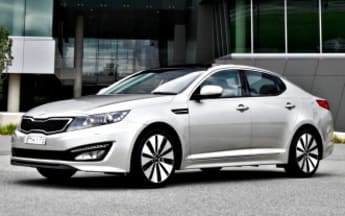It might be harder to be noticed if you haven’t been around for a while. But after an absence of about a year, Kia has given its new flagship every chance of grabbing buyers’ attention.
The largely unloved – and frankly unlovely – Magentis we knew is long gone. And the Korean carmaker’s bid for the top end of their range now rests on the incoming Optima. Like all cars in the Kia stable, it will have strategic pricing and still aims to offer a value proposition. But the front-drive mid-size sedan is the latest in the Kia range to focus more on style, quality and driving dynamics.
Value
Its main rivals will be the Mazda6 and Honda Accord from Japan, and fellow Korean Hyundai i45 – the latter especially challenging on both price and fresh design, in a world where even the concept sketches of a couple of years ago can start to look old.

While the Optima will be able to hold its own visually, it will come down to the final spec for Australia – and where it will sit on the price scale. The Magentis ranged from about $26,000 base model to just over $31,000 for top spec, and it’s hard to imagine Kia straying too far above those levels on a car they want to give showroom impact.
And there’ll likely be a few goodies on the equipment list. The Optima will initially arrive as the single upper-spec EX with add dual-zone climate control airconditioning, leather trim on steering wheel and gear level, wheel-mounted audio controls and auto-fold wing mirrors with LED indicators, Bluetooth and 7-in LCD nav system plus the premium iPod/USB/MP3-compatible audio system that includes a CD-changer and extra speaker power.
Technology
In Europe the Optima will be launched with two new engines: the 125kW 2.0-litre petrol and the 100kW/330Nm turbocharged ‘U2’ 1.7-litre diesel which has an optional stop-start system. However, we are not on the cards to get the diesel at this stage, as it’s shackled to the six-speed manual transmission, which Kia sees as being an unattractive prospect for Aussie buyers.
Instead we’ll get a direct-injected 2.4-litre petrol which, like the 2.0-litre, will have the choice of a six-speed sequential automatic with paddle-shifters on the steering – which Kia expects to be far more popular than the manual. The engine develops 148kW of power at 6300rpm and 250Nm of torque at 4250rpm. This is claimed to get it to 100km/h in 8.5 seconds with the manual and 9 seconds with the auto, and to a top speed of 210km/h.
As with the recently-launched Sportage, Kia has had Australian engineers working for six months on setting up the suspension and steering specifically to suit our roads, with changed spring rates and sway bars, dampers supplied from ZF Sachs, and a different valve on the steering rack.
Safety
The Optima will get a stacked safety list, with six airbags, anti-skid brakes with brake force distribution to send the effort to the right corners and brake assist to help apply extra anchor in emergencies, stability and traction control, hill-start assist and a reversing camera with the display integrated into the rear-view mirror.
Design
It looks very purposeful, sitting longer, lower and wider on a longer wheelbase. While it’s a four-door, Kia has followed the trend for coupe-ish shaping that trims the profile and lends some aerodynamic benefit in reducing drag – which is down to 0.29 from the previous 0.32) – and hence also fuel consumption.
And there’s ample opportunity to dress it up even further, with optional spec-ups in the form of a mesh grille, body kit, LED daytime running lights and tail lamps, and 18-in wheels with larger discs and black calipers.
The interior is a huge step up from the previous Optima, with the wraparound ‘cockpit’ well laid out and finished.
Driving
Since the suspension and steering work for Australia is not yet finished – although close to the final stages, only one of the test vehicles on hand was fairly close to what we’ll get, while the others had some of the suspension improvements but the Asian steering. The difference was noticeable in the steering, with the ‘near Aussie’ car having better turn-in and no sign of vagueness.
The Optima has decent acceleration off the line, and there’s no lack of enthusiasm from the 2.4 under what were fairly normal freeway and then back road driving conditions. Using the sequential side of the auto pins it down a bit more firmly, but the full auto side is capable enough for the kind of driver this car is intended for.
But what let the car down – badly – were the Nexen tyres the test vehicles were fitted with. Uncomfortably noisy on the smooth freeway surface, and harsh over the rutted roads out in the Korean countryside (admittedly very like Australian roads), the rubber undermined any of the good work the engineering team had done on the suspension.
Kia wants to position the Optima as a more premium package than the Magentis, but buyers are likely to be unimpressed by seeing it shod with the Nexens in the showroom – and even less impressed if they take it out for a test drive on them.
Kia Optima 2011: Platinum
| Engine Type | Inline 4, 2.4L |
|---|---|
| Fuel Type | Unleaded Petrol |
| Fuel Efficiency | 7.9L/100km (combined) |
| Seating | 5 |
| Price From | $9,020 - $12,650 |
| Safety Rating |
|
Range and Specs
| Vehicle | Specs | Price* |
|---|---|---|
| Platinum | 2.4L, Unleaded Petrol, 6 SPEED AUTOMATIC | $9,020 - $12,650 |





































.png)

-w.jpg)



.jpg)

